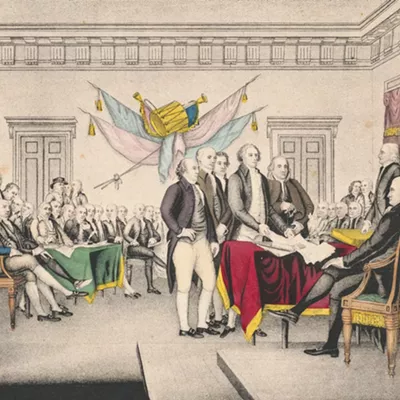When all else fails, when all the strategies they have learned and drills they have practiced and knowledge they have soaked up have been exhausted, and the clock is ticking down the seconds, Longfellow Elementary school teacher Erin Soliday advises her third-grade students to "just choose C."
Odd as it may seem, "C" -- the third option of four possible answers on a multiple choice test -- has been statistically shown to be correct about a third of the time, Longfellow teachers say. So if the students checked and double-checked their work, skipped the hard problems and came back to them, eliminated the answers that don't make sense (Mrs. Soliday's kids know that 63 & divide; 7 can't possibly equal 70), and there's still a problem they can't solve, then the third-graders in room 109 fill in C, and hope for statistics to fall on their side.
Being able to pass a test is already important in classrooms across Washington state, and it will be even more so if President George W. Bush's recently proposed education reform plans are adopted. That proposal is all about testing and consequences.
In Washington, D.C. -- nearly 2,000 miles away from Erin Soliday's third-graders -- Bush is trying his very best to cement his identity as "the Education President." To that end, along with tax cuts, Bush has made his education proposal a hallmark of his first few months in offices, visiting schools to sell his ideas and corralling legislators from liberal Sen. Ted Kennedy, D-Mass., to conservative Senate Majority Leader Trent Lott, R-Miss., to praise parts of his plan.
But even though Bush is the current poster boy for the education reform bandwagon, most states, including Washington and Idaho, have already left him in the dust when it comes to reforming schools. Testing and vouchers and charter schools -- all hallmarks of Bush's 2001 plan -- have been debated in most states for almost a decade by now. In part because of its bipartisan support, the Bush plan looks likely to become law. Then states will be faced with integrating new federal reforms with preexisting toughened state goals -- and assessing the success of both.
The Bush plan hits on familiar themes which have long been widely embraced by Republicans, and now seem to find support among Democrats, too. The centerpiece of his plan is on testing, a familiar buzzword to teachers and students in Washington state, who prepare in the fourth, seventh and 10th grades to take the Washington Assessment of Student Learning (WASL) tests in core subjects, as well as various other diagnostic and assessment tests given throughout the years.
Bush's plan ratchets testing up a notch, requiring students to take annual assessment tests from the third to the eighth grades. Those tests will be state-specific, but a sample group of children will also take the National Assessment for Educational Progress tests, against which all the individual state results will be measured.
States that post positive results on the tests will be eligible for funding bonuses.
For states and districts where results are less than expected, however, there can be severe consequences: after three consecutive years of under-performance by a school that receives federal Title1 funds (given to schools with high poverty rates), individual parents can apply for up to $1,500 of the funds that would otherwise go to the school. They can use that money to help cover the costs of a transfer to another public school, a private school or a private tutor.
Although the Bush plan never directly uses the hot-potato word, this aspect is equivalent to the concept of "vouchers," long derided by public education advocates as a way of funneling federal money to private schools.
Bush has also proposed spending about $600 million more on early reading programs, promised that under his plan a larger pool of funds would be available for those who want to establish charter schools and endorsed more teacher training and alternative methods of teacher certification.
Parts of the Bush plan have received support from many different corners -- for instance from American Federation of Teachers (an organization that has traditionally aligned with the Democratic Party), whose President Sandra Feldman, told Education Week that "it sounds like he's making a good proposal on reading."
But that doesn't mean that the Bush plan is without controversy. Whitworth Professor of Education Gregory Fritzberg, for one, says Bush has ignored what he calls "the achievement gap" -- the persistent disparity in test results between poor and middle-class students, between bilingual students and native English speakers and, because of the tenacious correlation between race and poverty, between minority and white children.
The Bush plan provides no clear funding source to close that gap, nor any direction to states to revamp the way that schools are funded to insure higher levels of equity, he says.
Washington is among a number of states that draws school funding sources from not only local property taxes, but also from statewide sales taxes, which smoothes out some of the inequities, Fritzberg says.
The Washington Education Association, which represents 70,000 teachers and school-support employees, also has concerns about the Bush plan, says the association's spokesman Rich Wood.
"No single test should be used to make high-stakes decisions about a child or a school," he says. "What matters is whether or not kids are actually learning."
Still, adds Wood, more immediate than the Bush plan is what is already happening in the state's own back yard.
"What is really important is what education reform looks like in our own state, rather than any proposal from the president," he says. He's backed up by Karin Short, the principal of Longfellow Elementary, where Erin Soliday teaches those third-graders.
"Shoot," she says, upon hearing more details of the Bush proposals. "We already do that now. What's new? Six years ago, we might have gone through the roof. But things have already changed completely from six years ago. We are much more targeted in our assessments, and we are much more accountable. And we are better."
Once upon a time, a long time ago, "reform school" meant a place where delinquent students were sent to right themselves. But for years now, in Washington state and in other states around the country, every school has been a reform school, as educators and legislators have tried new methods to improve old schools.
Essentially, whatever the fate of the Bush plan, Fran Mester, the executive director of Instructional Programs for District 81, says she believes that Spokane's largest school district is, "well positioned for whatever comes on national level, because of the work already done at the state level and by the local board."
A large grant from the Bill and Melinda Gates Foundation, which District 81 received last year, has made it possible for the district to push forward building computer labs and providing cutting-edge training for the teachers.
And on the assessment front, District 81 is currently performing a large study of middle and high schools which may change not only curricula but also the way classes and programs are structured.
But all of this didn't happen since last year. Most people date the modern era of education reform in Washington state to 1993, when the state legislature passed a sweeping education reform package, which predates many of the themes presented in the Bush plan and in the new administration's rhetoric.
The centerpiece of the 1993 reforms, says Edie Harding, a former education project manager at the Washington State Institute for Public Policy, was the introduction of "statewide central academic learning requirements," educational jargon translated as "Here are the things that Washington students are required to learn before they leave public school."
"It was like saying, all right, we have learning goals," says Harding. "People need to learn how to write and read with comprehension, to think analytically, to integrate experience and knowledge to solve problems." Then, she adds, came recommended tests to determine whether students were meeting those goals.
And so came the WASL test, which had clear implications for teachers and students. WASL results were publicized in newspapers and over the Internet, so that parents and communities could track how their local schools had performed.
Just last week, the state House of Representatives approved a bill to allow students and parents to view their own WASL scores, instead of just releasing school-wide results.
And for students, the real consequences will be felt beginning in 2008, where those who receive failing grades on the 10th-grade WASL will find their diplomas withheld.
But the education reform question has broadened beyond testing and test results. The A Plus Commission, formed in 1999, is considering ways to reward schools that post significant gains on the WASL, and the possibility of intervening in schools that have failed to show measurable improvements.
In the legislature, representatives are grappling with other persistent problems, like the perennial teacher shortages and how to fund the cost of living salary increases and smaller class sizes approved last November by voters.
To that end, Gov. Gary Locke has proposed allowing alternative certification methods for teachers, and rehiring some retired teachers, without imposing penalties on their pensions. There has also been talk about fiddling with the WASL, pushing back the date when passing it becomes a graduation requirement, for example, or delaying the implementation of the WASL in sciences, social studies, art and fitness.
Every district is different in its response to the WASL and to the reforms of the past seven years. But in District 81, Mester says meeting the WASL's demands has meant fresh rounds of training for teachers, and a commitment by the board to try to acquire new resources, technological and otherwise, to help schools cope with the requirements of test preparation.
Education by nature is evolutionary, so change should be expected. But no one -- not President Bush or the Washington State Legislature, or the hard-working principals of District 81 -- will ever come up with a magic solution that, like in Garrison Keilor's fictitious Lake Woebegone community, will result in all children being above-average.
Regardless, there will always be people willing to try their best. The irony is that assessment -- which is such a central concept in Washington state, and also at the core of the Bush plan -- can be tough to track when considering the success of the plans themselves.
In Washington state, for example, the era of education reform is still too new to pass judgment upon. WASL scores are up, true, but there are still areas of underperformance, and no one knows how much they will grow before leveling out.
Plus, there are all the unfactorable factors -- is the test fair for the state's minority population? For kids from a lower socioeconomic background? What if the state simply runs out of teachers to teach the test? Where do special education students fit into the picture? And gifted students? How to explain why a school's reading scores will zoom up one year and drop abruptly the next, especially when the same teachers are in the classrooms? How to preserve creativity while asking all children to prepare for the same, standardized test?
Still, though, many say there is much benefit in not settling for the status quo, in trying to make things better for the nation's children or for the 1.1 millions kids who attend school in Washington state.
"I think things have gotten more intentional [since '93]," says Harding. "People have gotten focused. There's kind of a purpose to what you do. The flip side is, there's less creativity, less time for happy turkey projects around Thanksgiving. [Reform] has weaned away some of the things teachers did that might have been fun, and said here are the things we need to focus on that are important. But I would still argue, you can make things fun. You just have to think about things in a different way."
Mester concurs: "I really do think that we are seeing some vast changes. We are putting some real pressure on the system to improve."
Back in Erin Soliday's class at Longfellow Elementary School, preparations for the math section of the Iowa Test of Basic Standards, to be given the following week, are going full steam.
Asked to figure out the area of a figure, one student observes, "I had to think on that one. It was hard."
But Soliday has faith in her kids, and she tells them so: "You guys will be so ready for this test."
"Yeah, yeah," one of her students says, under his breath.
Another is more optimistic: "I already know it all," he says.














